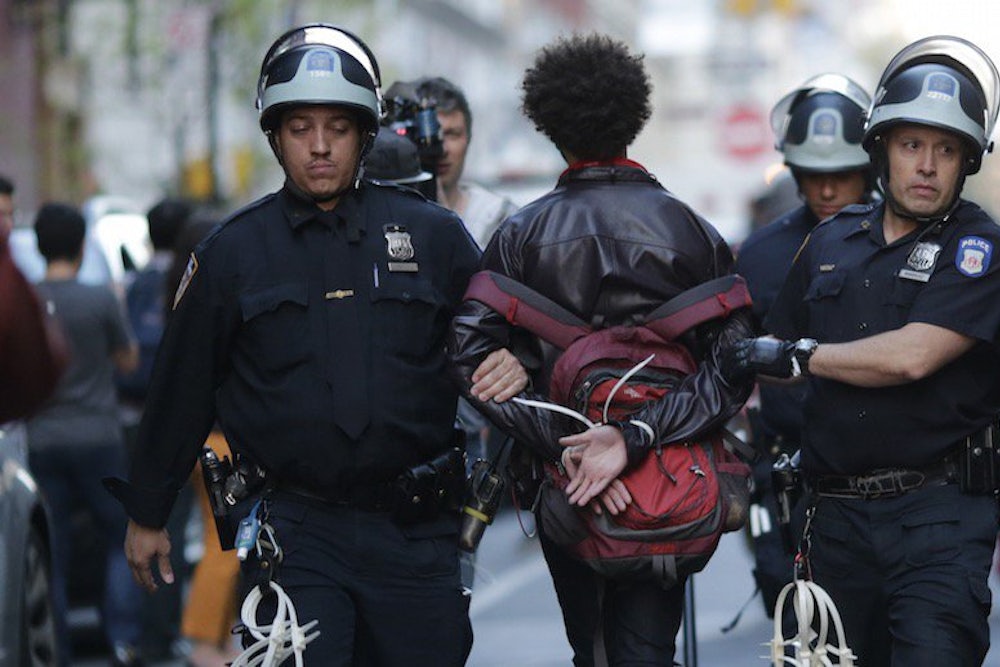They said Malcolm X’s father killed himself, too. Reverend Earl Little was an outspoken man on the subject of black liberation, a preacher who espoused the nationalist rhetoric of Marcus Garvey to his flock and to his children, including little Malcolm. When the reverend was found on railroad tracks near the family’s Lansing, Michigan home in 1931, his body nearly severed in half by the train that ran him over, the police flatly declared it a suicide, according to the civil rights leader’s seminal autobiography. The terrorism and arson that the Little family had endured from white supremacists was disregarded, overshadowed by the claims of police.
Earl Little didn’t die in police custody, but police are still the ones who determined the rather improbable ending to his story. (Why, if Little had actually chosen to end his life, would he choose bashing in his own skull and bisection by a locomotive as a method?) The history of black people, as well as other marginalized minorities, dying under mysterious circumstances is vast and stretches into our current American reality. From the very start of the American project, people of color have been commoditized, and inherently, commodities are not only disposable—they often are tossed away without explanation. Sometimes, especially when we’re in the company of police, we seem to die by our own hand in rather magical ways: We fire fatal gunshots into our bodies with hands cuffed behind our backs inside a police cruiser, for instance. Now, we have a similarly incredible explanation for Freddie Gray’s April 19 death, courtesy of a leak from the Baltimore Police Department.
Ever since we first saw citizen video evidence of his arrest shortly after it happened and learned of the fatal injuries he suffered, we’ve all been wondering exactly what happened to Gray. Up until last night, we only know that Gray suffered some kind of “forceful trauma” that nearly severed his spine and crushed his voice box; we also learned he received no medical treatment from the officers on hand. But on Wednesday night, the Washington Post published a report that stemmed from that police leak, containing the alleged account of a prisoner who had been placed in the same police van as Gray after his arrest. The unnamed prisoner, who is still in jail, could not see Gray in the van—yet according to the Post, he told investigators that he could hear Gray “banging against the walls” and believed that he “was intentionally trying to injure himself.” The Post story hadn’t been published for more than an hour before local journalists like WBAL’s Jayne Miller began debunking it, saying that it didn’t match her earlier reporting: Police commissioner Anthony Batts told media last Thursday that the second prisoner in the van said that Gray was “mostly quiet” and that there was no evidence that Gray was causing himself any harm. “We disagree with any implication that Freddie Gray severed his own spinal cord,” said Jason Downs, a Gray family attorney. “We question the accuracy of the police reports we’ve seen thus far, including the police report that says Mr. Gray was arrested without force or incident.”
Let’s entertain this notion, for a moment, that Gray had decided to injure himself or end his life over an arrest that began with an errant look at an officer, or because he happened to be carrying a switchblade. Is it realistic to believe he would have succeeded to this tragic degree? Whoever at the Baltimore Police Department leaked this clearly relied upon us not understanding how much physical force is required to nearly sever one’s own spine and crush a voice box, all while handcuffed. One doctor told the Baltimore Sun that Gray’s injuries were more consistent with those seen from high-speed vehicle crashes. The van made several stops while he was in it, but did not crash even at a low speed.
Granted, this wasn’t the first time someone tried to explain away what common sense tells us was police brutality. Conservative outlets had circulated nonsense about Gray having a pre-existing spinal condition that required surgery days before his arrest. But now we have the Baltimore Police Department, using the Post as an uncritical conduit, trolling the public and the media. Yes, that seems unwise in light of the violent unrest we’ve seen this week. Far more disturbing than a question of their policing strategy, however, is what this leak indicates about this department and the answers it's willing to offer.
No matter how many shouts are heard or windows smashed, the Baltimore police have asserted that they control the narrative, and that they alone determine what we get to know about why Gray died. They have no respect for Baltimore’s anger. That’s a lot more chilling to me than teenagers tossing bricks.
The leak emerged the night before Baltimore police announced, one day earlier than promised, that they have concluded their investigation into the Gray incident, and are passing along their findings to city prosecutors. The state’s attorney, Marilyn Mosby, will be the one who determines whether any of the six officers currently on suspension will face criminal charges. But the public won’t learn anything new today. In this and all cases, we shouldn’t have to wait until an indictment is or isn’t handed down to find out what happened, all the while contending with insultingly absurd explanations about how we just seem to magically die in the hands of police.
